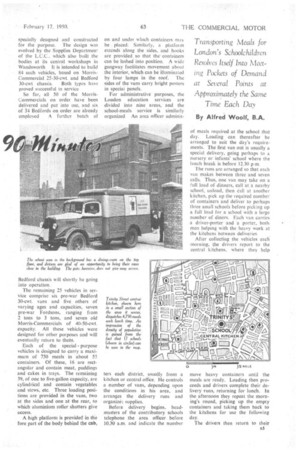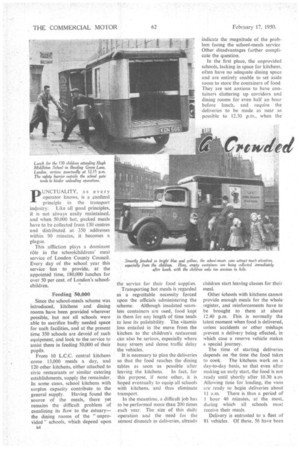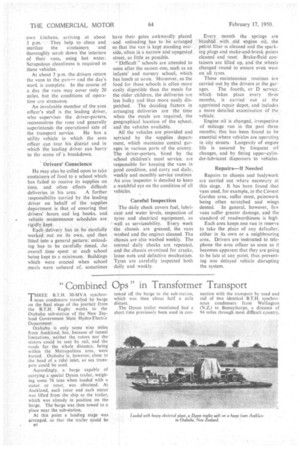Transporting Meals for London's Schoolchildren Resolves Itself Into Meeting Pockets of Demand at Set era! Points at Approximately the Same
Page 39

Page 38

Page 40

If you've noticed an error in this article please click here to report it so we can fix it.
Time Each Day
By Alfred Woolf, B.A.
PUNCTUALITY, as every operator knows, is a cardinal principle in the transport
industry. Like all good principles, it is not always easily maintained, and when 50.000 hot, packed meals have to be collected from 130 centres and distributed at 350 addresses within 90 minutes, it becomes a plague.
This affliction plays a dominant role in the schoolchildrens' meal service of London County Council. Every day of the school year this service has to . provide, at the appointed time, 180,000 lunches for over 50 per cent. of London's school children.
Feeding 50,000 Since the school-meals scheme was introduced, kitchens and dining rooms have been provided wherever possible, but not all schools were able to sacrifice badly needed space for such facilities, and at the present time 350 schools are devoid of such equipment, and look to the service to assist them in feeding 50,000 of their pupils.
From 10 L.C.C. central kitchens come 13,000 meals a day, and 120 other kitchens, either attached to civic restaurants or similar catering establishments, supply the remainder. In some cases. school kitchens with surplus capacity contribute to the general supply. Having found the source of the meals, there yet remains the difficult problem of canalizing its flow to the estuary— the dining rooms of the " unprovided " schools, which depend upon 34 the service for their food supplies. Transporting hot meals is regarded as a regrettable necessity forced upon the officials administering the
scheme. Although insulated seamless containers are used, food kept in them for any length of time tends to lose its palatability. The vitamin loss entailed in the move from the kitchen to the children's restaurant can also be serious, especially where busy streets and dense traffic delay the vehicles.
It is necessary to plan the deliveries so that the food reaches the dining tables as soon as possible after
leaving the kitchens. In fact, for this purpose, if none other, it is hoped eventually to equip all schools with kitchens, and thus eliminate transport.
In the meantime, a difficult job has to be performed more than 200 times each year. The size of this daily operation and the need for the utmost dispatch in deliveries, already
indicate the magnitude of the problem facing the school-meals service Other disadvantages further complicate the question.
In the first place, the unprovided schools, lacking in space for kitchens, often have no adequate dining space and are entirely unable to set aside room to store the containers of food. They are not anxious to have containers cluttering up corridors and dining rooms for even half an hour before lunch, and require the deliveries to be made as near as possible to 12.30 p.m., when the
children start leaving classes for their meal.
Other Schools with kitchens cannot provide enough meals for the whole register, and reinforcements have to be brought to them at about 12.40 p.m. This is normally the latest moment when food is delivered, unless accidents or other .mishaps prevent a delivery being effected, in which case a reserve vehicle makes a special journey.
'The time of starting deliveries depends on the time the food takes to cook. The kitchens work on a day-to-day basis, so that even after making an early start, the food is not ready until 'shortly after 10.30 a.m. Allowing time for loading, the vans are ready to begin deliveries about 11 a.m. There is thus a period of 1 hour 40 minutes, at the most, during which all schools must receive their meals.
Delivery is entrusted to a fleet of 81 vehicles. Of these. 56 have been
specially designed and constructed for the purpose. The design was evolved by the Supplies Department of the L,(2.C. which also built the bodies at its central workshops in Wandsworth It is intended to build 84 such vehicles, based on MorrisCommercial 25-30-cwt. and Bedford 30-cwt chassis. Both types have proved successful in service So far, all 50 of the MorrisCommercials on order have been delivered and put into use, and six of 34 Bedfords on order are already employed A furthcr batch of Bedford chassis will shortly he going into operation.
The remaining 25 vehicles in service comprise six pre-war Bedford 30-cwt. vans and five others of varying ages and capacities, seven pre-war Fordsons, ranging from 2 tons to 3 tons, and seven old Morris-Commercials of 40-50-cwt. capacity. All these vehicles were designed for other purposes and will eventually return to theim.
Each of the special purpose vehicles is designed to carry a maximum of 750 meals in about 55 containers. Of these, 16 are rectangular and contain meat, puddings and cakes in trays. The remaining 39, of one to five-gallon capacity, are cylindrical and contain vegetables and stews, etc. Three loading positions are provided in the vans, two at the sides and one at the rear, to which aluminium roller shutters give access.
A high platform is provided in the fore part of the body behind the cab, on and under which containers ma y be placed; Similarly, a platform extends along the sides, and hooks are provided, so that the containers can be lashed into position. A wide gangway facilitates movement about the interior, which can be illuminated by four lamps in the roof. The sides of the vans carry bright posters in speciai Panels.
For administrative purposes, the London education services are divided into nine areas, and the school-meals service is similarly organized An area officer adminis ters each district, usually from a kitchen or central office, He controls a number of vans, depending upon the conditions in his area, and arranges the delivery runs and organize'.; supplies.
Before delivery begins, headmasters of the contributory schools telephone the area officer before 10.30 a.m. and indicate the number of meals required at the school that day. Loading can thereafter be arranged to suit the day's requirements. The first van out is usually a special delivery, going perhaps to a nursery or infants' school where the lunch break is before 12.30 p m.
The runs are arranged so that each van makes between three and seven calls. Thus, one van may take on a full load of dinners, call at a nearby school, unload, then all at another kitchen, pick up the required number of containers and deliver to perhaps three small schools before picking up a full load for a school with a large number of diners. Each van carries a driver-porter and a porter, both men helping with the heavy work at the kitchens between deliveries After collecting the vehicles each morning, the drivers report to the central kitchens, where they help move heavy containers until the meals are ready. Loading then proceeds and drivers complete their delivery runs, returning for lunch. In the afternoon they repeat the morning's round, picking up the empty containers and taking them back to the kitchens for use the following day.
The drivers then return to their a5
own kitchens, arriving . at about 3 p.m. They help to clean and sterilize the containers and thoroughly scrub down the interiors of their vans, using hot water. Scrupulous cleanliness is required in these vehicles.
At about 5 p.m. the drivers return the vans to the gariirrP and the day's work is complete. In the course of a day the vans may cover only 20 miles, but the conditions of operation are strenuous.
An invaluable member of the area officer's staff is the leading driver, who supervises the driver-porters, reconnoitres the runs and generally superintends the operational side of the transport service. He has a utility vehicle in which the area officer can tour his district and in which the leading driver can hurry to the scene of a breakdown.
Drivers' Conscience
He may also be called upon to take containers of food to a school which has failed to receive its supplies on time, and often effects difficult deliveries in his area. A further responsibility carried by the leading driver on behalf of the supplies department is that of ensuring that drivers' hours and log books, and vehiclemaintenance schedules are rigidly kept.
Each delivery has to be carefully worked out on its own, and then fitted into a general pattern; unloading has to be carefully timed, he overall time spent at each school being kept to a minimum. Buildings which were erected when school meals were unheard of, sometimes
have their gates awkwardly placed -and unloading has to be arranged so that the van is kept standing outside, often in a narrow and congested street, as little as possible.
" Difficult " schools are attended to soon after the easiest one, such as an infants' and nursery school, which has lunch at noon. Moreover, as the food for these schools is often more easily .digestible than the meals for the older children, the deliveries are less bulky and thus more easily dispatched. The deciding factors in arranging deliveries are the time when the meals are required, the geographical location of the school, and the vehicles available.
All the vehicles are provided and serviced by the supplies department, which maintains central garages in various parts of the county. The driver-porters, hired by the school children's meal service, are responsible for keeping the vans in good condition, and carry out daily, weekly and monthly service routines An area inspector is detailed to keep a watchful eye on the condition of all vehicles.
Careful Inspection The daily check covers fuel, lubricant and water levels, inspection of tyres and electrical equipment, as 2 well as serviceability. Every week the chassis are greased, the vans
• washed and the engines cleaned. The chassis are also washed weekly. The normal daily checks are repeated. and the chassis examined for cracks, • loose nuts and defective mechanism. Tyres are carefully inspected both daily and weekly.
• Everythe springs are brushed. With .old engine oil, the petrol filter -is cleaned and the sparking plugs and make-and-break points cleaned and reset. Brake-fluid containers are filled up, .and the wheels changed round to ensure even wea:. on all tyres.
These maintenance routines are carried out by the drivers at the gar
ages. The fourth, or D service, which takes place every three months, is carried • out at the appointed repair depot, and includes a more detailed examination of the_ vehicle.
Engine oil is changed, irrespective of mileage run in the past three months; this has been found to be essential where vehicles are operating in city streets. Longevity of engine life is assured by frequent oil changes, and by fitting upper-cylinder-lubricant dispensers to vehicles.
Repairs—if Needed
Repairs to chassis and bodywork are carried out where necessary at this stage. It has been found that vans used, for example, in the Covent Garden area, suffer most, paintwork being often scratched and wings dented. In general, however, few vans suffer greater damage, and the standard of roadworthiness, is high
Each area keeps one van in reserve to take the place of any defaulter, either in its own or a neighbouring area Drivers are instructed to telephone the area officer as soon as it becomes apparent that they are going to be late at any point, thus preventing one delayed vehicle disrupting the system.




























































































